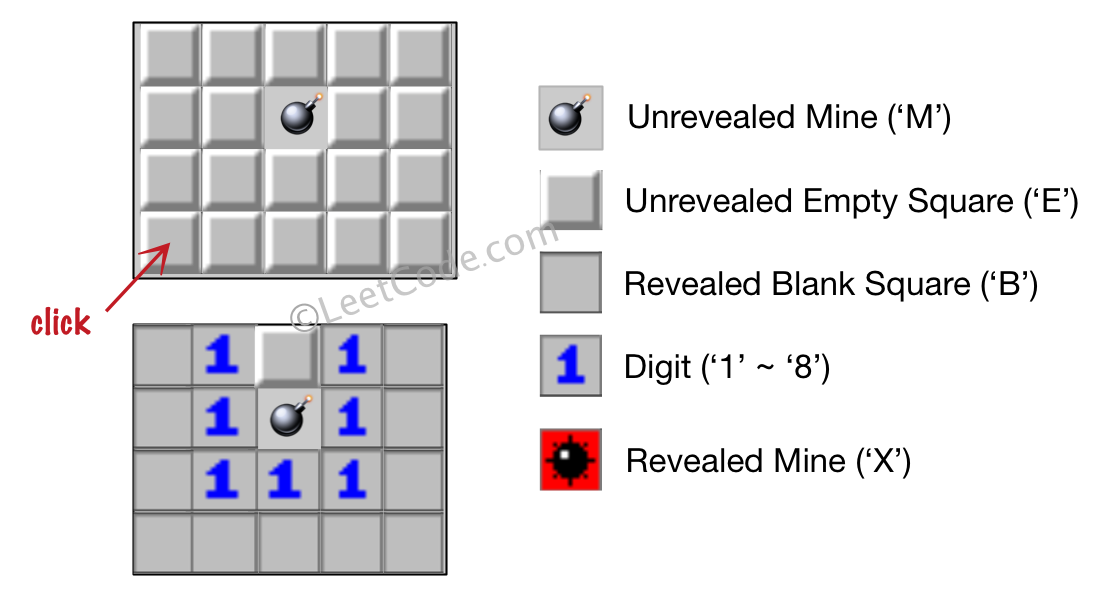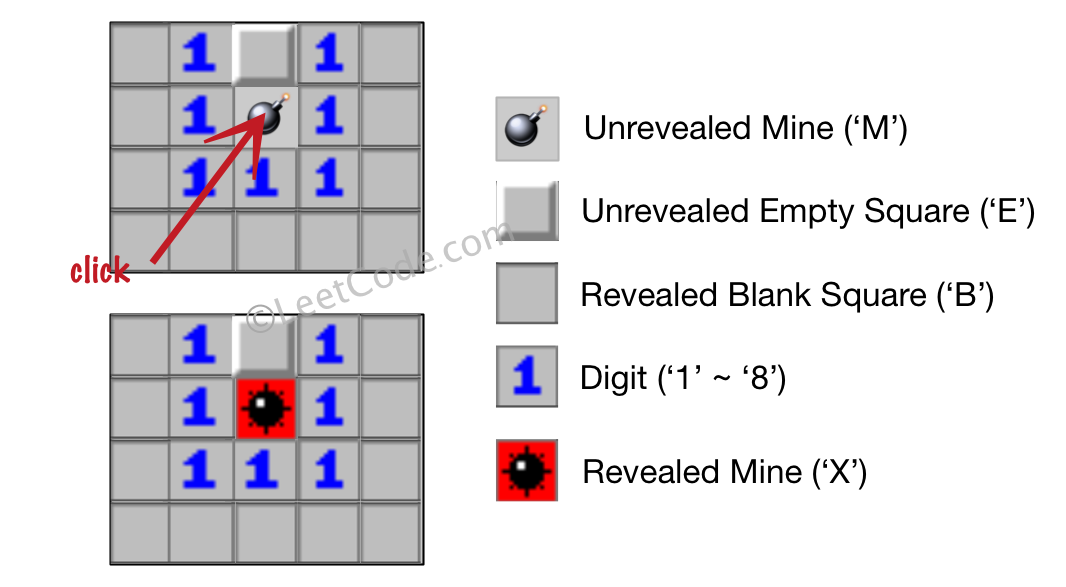Description:
Let's play the minesweeper game (Wikipedia, online game)!
You are given a 2D char matrix representing the game board. 'M' represents an unrevealed mine, 'E'represents an unrevealed empty square, 'B' represents a revealed blank square that has no adjacent (above, below, left, right, and all 4 diagonals) mines, digit ('1' to '8') represents how many mines are adjacent to thisrevealed square, and finally 'X' represents a revealed mine.
Now given the next click position (row and column indices) among all the unrevealed squares ('M' or 'E'), return the board after revealing this position according to the following rules:
- If a mine ('M') is revealed, then the game is over - change it to 'X'.
- If an empty square ('E') with no adjacent mines is revealed, then change it to revealed blank ('B') and all of its adjacent unrevealed squares should be revealed recursively.
- If an empty square ('E') with at least one adjacent mine is revealed, then change it to a digit ('1' to '8') representing the number of adjacent mines.
- Return the board when no more squares will be revealed.
Example 1:
Input: [['E', 'E', 'E', 'E', 'E'], ['E', 'E', 'M', 'E', 'E'], ['E', 'E', 'E', 'E', 'E'], ['E', 'E', 'E', 'E', 'E']] Click : [3,0] Output: [['B', '1', 'E', '1', 'B'], ['B', '1', 'M', '1', 'B'], ['B', '1', '1', '1', 'B'], ['B', 'B', 'B', 'B', 'B']] Explanation:
Example 2:
Input: [['B', '1', 'E', '1', 'B'], ['B', '1', 'M', '1', 'B'], ['B', '1', '1', '1', 'B'], ['B', 'B', 'B', 'B', 'B']] Click : [1,2] Output: [['B', '1', 'E', '1', 'B'], ['B', '1', 'X', '1', 'B'], ['B', '1', '1', '1', 'B'], ['B', 'B', 'B', 'B', 'B']] Explanation:
1.遇到数字位置停止遍历。
2.每tack一个位置,DFS遍历该位置的其它方向位置。
void detect(vector<vector<char> >& board1, int x1, int y1);
class Solution {
public:
vector<vector<char> > updateBoard(vector<vector<char> >& board, vector<int>& click) {
if(board[click[0]][click[1]] == 'M'){
board[click[0]][click[1]] = 'X';
return board;
}
detect(board, click[0], click[1]);
return board;
}
};
bool isqua(vector<vector<char> >&board, int x, int y){
if(x < board.size() && x >= 0){
if(y < board[0].size() && y >= 0) return true;
}
return false;
}
void detect(vector<vector<char> >& board, int x, int y)
{
if(!isqua(board,x,y))return;
int count = 0;
if(board[x][y] == 'E'){
if(isqua(board,x-1,y-1) && board[x-1][y-1] == 'M') count++;
if(isqua(board,x-1,y) && board[x-1][y] == 'M') count++;
if(isqua(board,x-1,y+1) && board[x-1][y+1] == 'M') count++;
if(isqua(board,x,y-1) && board[x][y-1] == 'M') count++;
if(isqua(board,x,y+1) && board[x][y+1] == 'M') count++;
if(isqua(board,x+1,y-1) && board[x+1][y-1] == 'M') count++;
if(isqua(board,x+1,y) && board[x+1][y] == 'M') count++;
if(isqua(board,x+1,y+1) && board[x+1][y+1] == 'M') count++;
if(count > 0) board[x][y] = count + '0';
else{
board[x][y] = 'B';
detect(board,x-1,y-1);
detect(board,x-1,y);
detect(board,x-1,y+1);
detect(board,x,y-1);
detect(board,x,y+1);
detect(board,x+1,y-1);
detect(board,x+1,y);
detect(board,x+1,y+1);
}
}
}







 本文详细解析了扫雷游戏的实现算法,通过递归深度优先搜索(DFS)的方法揭示了如何根据点击位置更新游戏面板的状态。包括处理空格、数字格及雷区的逻辑,并附带示例代码。
本文详细解析了扫雷游戏的实现算法,通过递归深度优先搜索(DFS)的方法揭示了如何根据点击位置更新游戏面板的状态。包括处理空格、数字格及雷区的逻辑,并附带示例代码。


















 被折叠的 条评论
为什么被折叠?
被折叠的 条评论
为什么被折叠?








